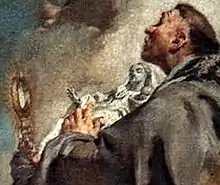Hyacinth of Poland
Hyacinth (Polish: Święty Jacek or Jacek Odrowąż; c. 1185 – 15 August 1257) was a Polish Dominican priest and missionary who worked to reform women's monasteries in his native Poland. He was a Doctor of Sacred Studies, educated in Paris and Bologna.
Hyacinth | |
|---|---|
 Apparition of the Virgin to Saint Hyacinth, Ludovico Carracci (1592), in the Louvre Museum | |
| Confessor | |
| Born | c. 1185 Kamień Śląski, Silesia, Poland |
| Died | 15 August 1257 Kraków, Lesser Poland, Poland |
| Venerated in | Roman Catholic Church Aglipayan Church |
| Canonized | 17 April 1594 by Pope Clement VIII |
| Feast | 17 August |
| Attributes | Holding a statue of the Blessed Virgin Mary along with a monstrance or ciborium[1] |
Life
Called the "Apostle of the North", Hyacinth was the son of Eustachius Koński of the noble family of Odrowąż. He was born in 1185 at the castle of Lanka, at Kamień, in Silesia, Poland. A near relative of Ceslaus, he made his studies in notable cities: Kraków, Prague, and Bologna, and at the latter place merited the title of Doctor of Law and Divinity. On his return to Poland he was given a prebend at Sandomierz, a medieval centre of administration in the south-eastern part of the country. He subsequently accompanied his uncle Ivo Konski, the Bishop of Kraków, to Rome.[2]
While in Rome, he witnessed a miracle performed by Dominic of Osma, and became a Dominican friar, along with Ceslaus and two attendants of the Bishop of Kraków, Herman and Henry. In 1219 Pope Honorius III invited Dominic and his followers to take up residence at the ancient Roman basilica of Santa Sabina, which they did by early 1220. Before that time, the friars had only a temporary residence in Rome at the convent of San Sisto Vecchio which Honorius III had given to Dominic in about 1218, intending it to be used for a reformation of Roman nuns under Dominic's guidance. Hyacinth and his companions were among the first to enter the convent. They were also the first alumni of the studium of the Dominican Order at Santa Sabina out of which would grow the 16th century College of Saint Thomas at Santa Maria sopra Minerva, which became the Pontifical University of Saint Thomas Aquinas in the 20th century. After an abbreviated novitiate, Hyacinth and his companions received the religious habit of the Order from Dominic himself in 1220.[2]
The young friars were then sent back to their homeland to establish the Dominican Order in Poland and Kyiv. As Hyacinth and his three companions traveled back to Kraków, he set up new monasteries with his companions as superiors, until finally he was the only one left to continue on to Kraków. Hyacinth went throughout Northern Europe spreading the faith. He died in the year 1257.[3] Tradition holds that he also evangelized throughout Sweden, Norway, Denmark, Prussia, Scotland, Russia, Turkey, and Greece. However, these travels are heavily disputed and are not supported by the earliest hagiographies of Hyacinth.
Legend

_E911a_22.jpg.webp)
One of the major miracles attributed to Hyacinth came about during a Mongol attack on Kyiv. As the friars prepared to flee the invading forces, Hyacinth went to save the ciborium containing the Blessed Sacrament from the tabernacle in the monastery chapel, when he heard the voice of Mary, the mother of Jesus, asking him to take her, too.
Hyacinth lifted the large, stone statue of Mary, as well as the ciborium. He was easily able to carry both, despite the fact that the statue weighed far more than he could normally lift. Thus, he saved them both. For this reason, he is usually shown holding a monstrance (though they did not come into use until several centuries later)[4] and a statue of Mary.[5]
The Polish exclamation Święty Jacku z pierogami! ("St. Hyacinth and his pierogi!") is an old-time saying, a call for help in some hopeless circumstance.[6] It has derived from two legends. One of them is about his visit on July 13, 1238, to Kościelec. During his visit, a hailstorm broke out, destroying crops and leaving people with the terrible prospect of poverty and famine. Hyacinth told them to pray. The next day, the crops were miraculously restored. The people then treated Hyacinth to pierogi made from those crops as a token of gratitude. The second legend mentions Hyacinth feeding people with pierogi during a famine caused by the Mongol invasion of 1241.[7]
Veneration
The tomb of Hyacinth is in the Basilica of Holy Trinity in Kraków, Poland, in a chapel that bears his name.[8]
Hyacinth was canonized on 17 April 1594 by Pope Clement VIII,[2] and his memorial day is celebrated on 17 August. In 1686 Pope Innocent XI named him a patron of Lithuania. He is the patron saint of those in danger of drowning and weight lifting.
Among notable churches in North America dedicated to Hyacinth of Poland is St. Hyacinth's Basilica in Chicago, Illinois.
See also
References
- Stracke, Richard (2015-10-20). "Saint Hyacinth: The Iconography". Christian Iconography.
- Mershman, Francis (1910). "St. Hyacinth". The Catholic Encyclopedia. Vol. 7. New York: Robert Appleton Company.
- Fabyan Windeatt, Mary (2009). St. Hyacinth of Poland. TAN Books. ISBN 978-0895554222.
- "Ostensorium (Monstrance)". Catholic Encyclopedia.
- "St. Hyacinth". Saints.SPQN.com. 2008-12-26.
- "Św. Jacku z pierogami". Gazeta Wrocławska (in Polish). 2009-08-21.
- "O cudach św. Jacka, który karmił krakowian pierogami". Gazeta Krakowska (in Polish). 2013-08-15.
- DiPippo, Gregory (2011-08-17). "The Dominican Church of the Holy Trinity in Krakow". New Liturgical Movement. Retrieved 2011-10-18.
External links
- "Saint Hyacinth". Archived from the original on 2008-09-08.
- "Colonnade Statue in St Peter's Square".